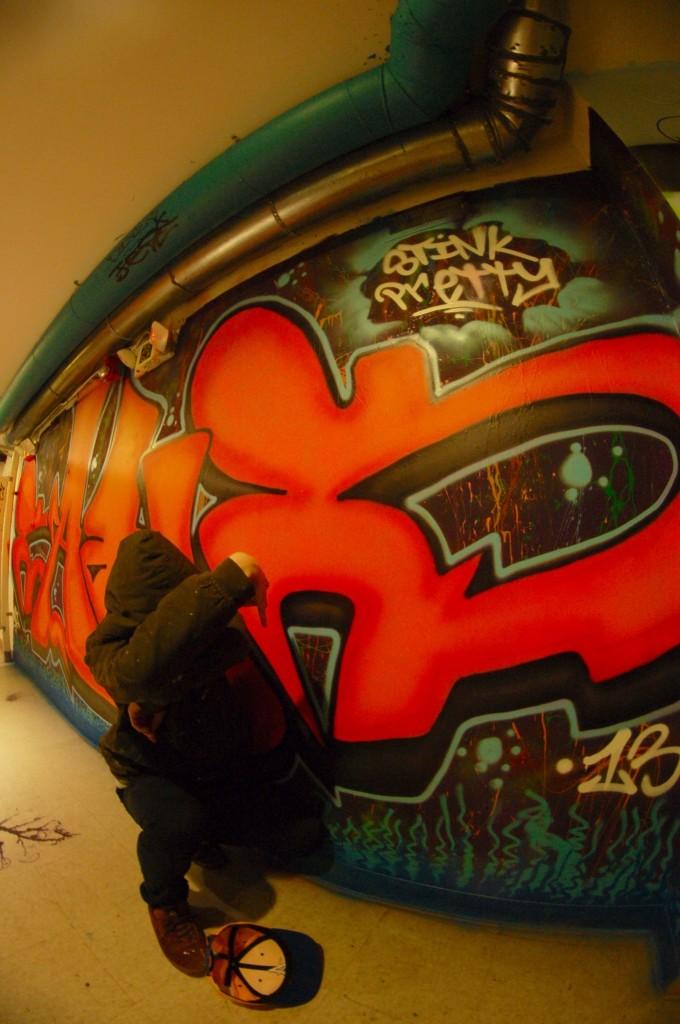Early summer, 1998. Felch Street Underpass, Ann Arbor.
Six friends assembled below an underpass in the middle of the night to complete a mural. They did so illegally. They were a group of rebels, but for good cause. The Felch Street Underpass was covered with profanities and the kids all lived in that neighborhood. They were trying to make a statement with their own artwork that trumped the negativity that was being displayed at the underpass at the time.
That was when the cops rolled up. The kids instinctively scattered, but ultimately decided not to run. They were taken to the police station, fingerprinted, and charged with malicious destruction of property. A court date was set.
In the weeks before the court date, a friend gathered signatures from the neighborhood, saying that the mural was not malicious or destructive, that the goal was to beautify the neighborhood. The underpass was private property owned by the Ann Arbor railroad, so the group asked the railroad for permission to finish the mural and do more painting, which the railroad supported fully. In court, all charges were dropped based on the overwhelming support from the community. Each of the kids was given permission to do murals underneath all the underpasses that summer. With their new blank canvases, they painted eight beautiful murals.
At that point, Mary Thiefels was nineteen years old, and she realized she wanted to do more.
SAES
Before April 2013, Matt Carter* had an alter-ego. Carter, a freshman at Community High School, spent hours each day around Ann Arbor, tagging his moniker, “SAES,” on buildings, bridges, roofs, and more surfaces. Carter now faces serious charges and possible jail time for his tagging, including 16 counts of malicious destruction of personal property (MDPP) and malicious destruction of a building (MDB). Each of the counts was charged between Dec. 1, 2012 and March 15, 2013, and each count carries a potential punishment of five years in prison and/or $10,000, or 3 times the amount of destruction of property. A preliminary hearing was held on April 26, 2103, in which Carter was represented by attorney Lynn B. D’ORio. Carter’s case report read:
“IT IS ORDERED:
Matt is placed on House Arrest and Night Surveillance. On Monday April 26, 2013 the minor is placed on GPS tether. Minor must submit to drug screens as arranged by the probation department.”
On Thursday, May 2, Carter was arrested at his home in Ann Arbor for violating his probation. He had missed his third block at Community High School on the Monday before. The case read, “On 4/29/13 Matt failed to attend school and was not excused by probation officer. His whereabouts were unknown.” He was held in a Juvenile Detention Facility until he was tried on May 15 before the case referee. His mother, father and grandmother requested his return home. An additional two weeks was added on to his current stay in the facility.
The Graffiti Artists
“Graffiti is not art. It’s vandalism. It’s not malicious vandalism, but we are out there destroying,” said a local Ann Arbor street artist who goes by the moniker “P.R. Monster.” His signature pieces are small multi-colored characters resembling monsters. “Most people dig my work. The people who hate me hate me…Which I love, means I’m doing something right. The public hates tags the most. They don’t see what goes into it. All the creativity, time, and energy… I like the idea that I have the power to change my visual environment.”
Ryan Jacobs*, a close friend of Carter, argued that Carter is truly talented at what he does and uses it an outlet for his emotions. “Through skating many skaters find therapy… I cannot go a day without skating. But for Matt it’s painting. Going a day without painting doesn’t feel right.”
Jacob Saalberg, another local graffiti artist, was charged with malicious destruction of property in March 2012 at the age of 17. Saalberg accepted his punishment of $19,319.92 in fines and two years of probation, but still feels passionately about the issue, “My personal stance on graffiti is that it is a form of self expression, that is illegal, but not necessarily wrong in all cases, if you can get your head around that. Tell me there’s not a gray area when it comes to the law. Affirmative action, abortion laws, taxes, are all hot issues and deal with different people’s opinions on what’s wrong and what’s right,” Saalberg said. Saalberg called Carter’s ordeal “sad, ridiculous and awesome.”
The Experts
Since her court date in 1998, Mary Thiefels has been an active street artist in Ann Arbor and other communities. She received her first commission to paint the Main Street underpass, visible on entering Ann Arbor, which is still looking sharp. In 2007 Thiefels founded Tree Town Murals, which consults with communities, schools, nonprofits, corporations and individuals to create mural art. “Each project is unique,” said Theifels. “Each one gets better and better over the years. Communities are turning to public art to re-establish morale and attract people to the cities.” She now works at the Neutral Zone with many young artists, running the Visual Arts Council. Thiefels, a big supporter of street art as an art form, aspires to keep Ann Arbor’s street art scene on the right side of the line between art and vandalism.
Thiefels said, “There’s a lot of really unsightly vandalism and tag art in our community. And I want to meet these artists and say, hey, do you really wanna learn how to paint graffiti? Let’s do that. I’ll show you. I will give you a wall, we’ll make sure it’s legal, I will bring in some of the best graffiti artists in southeast Michigan, and let’s get it done. Graffiti is a recognized contemporary art form. It is a very very skilled, crafted art form. I think when you’re young, you wanna try things out, you wanna practice. So giving opportunities to do that [without] kids landing themselves in hundreds of thousands of dollars of debt, that’s my goal… We need to provide productive public art opportunities for young aspiring artists.”
This method has proven effective in Philadelphia, PA, where Jane Golden founded the Mural Arts Program in 1984. The program hires artists, including prosecuted graffiti artists,and has painted over 3,600 murals around Philadelphia. Graffiti in the city has since decreased because of the would-be vandals turned artists legally beautifying the city.
Steve Coron, CHS art teacher, expressed his feelings about graffiti. “I do have some feelings about graffiti relative to art, and I come at that from two directions: as an artist, and as a business owner in Ann Arbor.” He points out that some graffiti is more than just a scrawl on a wall, that it serves a purpose. “When we go to Italy and we go to Pompei and go to the Forum you can see how people communicated by writing on walls. This is not a new thing. It’s a form of communication and expression. It’s how people who were poor and underrepresented had a chance to get back at the people who ran the place. People need to know what it’s really about… So what writing about this does is bring people together to think about all the people involved in this milieu we call graffiti,” Coron said.
On Carter, Coron commented, “I haven’t seen much of his art. I saw a little bit of his art [at school], and he was developing a style, I call it street, which I respect as an art form… I think why this is in the news right now is because our town is covered with tags on buildings that belong to other people and frankly, they’re pissed off.
“If people tag all over, they think ‘It’s all about me.’ Okay, it’s all about you. Now you need to face the music,” he said
Thiefels also has her doubts about some of Ann Arbor’s current graffiti scene: “Right now in Ann Arbor, in such a small town, to be running around vandalizing is just — you’re asking for it.”
Vandals or Van Goghs?
At the heart of the war between the vandals and the vandalized lies a very fine line between art and destruction. This line has proven undefinable, or rather the definition will change with each response and each individual.
Coron struggled with this concept: “I can’t make the distinction [between art and vandalism]. I can’t define that. Law enforcement agencies have already defined that, or they try to. Vandalism is destroying someone else’s property. It’s an unwanted change to the structure… Do I appreciate thoughtful, well-executed graffiti, graffiti that I think takes some real skill? I think it’s amazing to see what people can do with a spray paint can and how they draw. So as an art teacher, I respond to that… I do not really like just someone’s tag on the side of every possible surface in town.
“If that’s part of their art, to push ideas or to push society to think about art in a different way, great, but they have to know what they’re getting into, because there’s a big push the other way.”
One thing is for sure. Graffiti has increased tremendously in Ann Arbor recently, and it would be an understatement to say that SAES has been right there in the center of it. “Ann Arbor has exploded in the last year, year and a half, and it’s a joy to watch it grow and develop into a real underground scene,” said P.R. Monster.
Coron is not quite as enthusiastic about this growth: “I know that some people who run around with spray cans consider running from the cops, and getting away with it, and just tagging a building as part of their art. And I know the thrill of that. To be honest with you, I’m not there yet, with appreciating that aspect. I can’t get behind the fact that someone is just taking it upon themselves to tag someone’s building. But what if it’s done on a cement wall under the train tracks or on a rock down by the river? Then we can enter the issue of aesthetics, what’s beautiful and what’s not? It’s asking us to question what’s art, what isn’t art.”
The Punishment
The law has ascertained that graffiti is illegal, but is jail time the best way to accomplish their agenda of reforming the vandals and the city?
The Ann Arbor community has expressed mixed opinions on this case. Many people feel that Carter deserves a harsher punishment. On an annarbor.com article, a user named getagrip commented that Carter should recieve “no mercy, they or their parents must pay, even if it takes years. These are community criminals, they attack our entire community, ruin personal property, and post it as if they should be proud of it.”
Another user under the name “texaswede” disagreed, saying, “I am not excusing them, but they are kids. Yes, stupid kids. But kids. Undisciplined ones. Let us hope this brings a bit of sense to them. All of you advising and wishing for harsher punishment should think back to your own stupid acts in adolescence. We all did something not so sensible.”
The P.R. Monster spoke his mind from the opposing side of the issue: “Jail is one of the worst things you could give someone for painting a mm of paint on a wall. It’s insane to even charge someone with a felony for it. Fines. Fines. Fines. And a whole lot of community service. What benefit does it have for society to put us in a cell for graffiti? At best, we’d be a burden on the taxpayers. Put us to work.
“Make us clean up the city that we’ve been destroying.”
Photo courtesy to Addison Kuppina.
*Name has been changed.

















